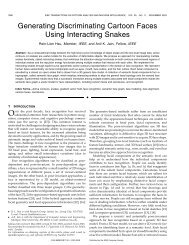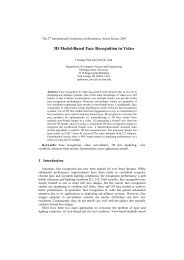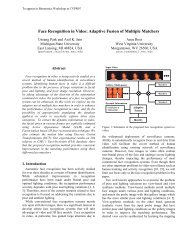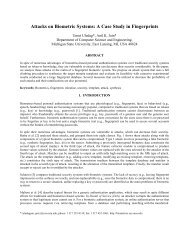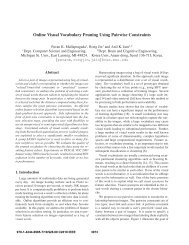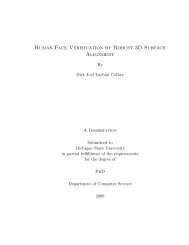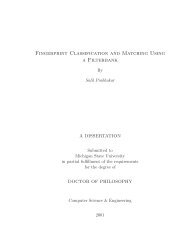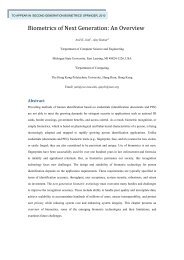Face Detection and Modeling for Recognition - Biometrics Research ...
Face Detection and Modeling for Recognition - Biometrics Research ...
Face Detection and Modeling for Recognition - Biometrics Research ...
Create successful ePaper yourself
Turn your PDF publications into a flip-book with our unique Google optimized e-Paper software.
(f ⊕ g σ )(x, y) = Max{f(x − c, y − r) + g(c, r)};<br />
(f ⊖ g σ )(x, y) = Min{f(x − c, y − r) + g(c, r)};<br />
(x − c, y − r) ∈ F, (c, r) ∈ G ,<br />
(3.3)<br />
(x − c, y − r) ∈ F, (c, r) ∈ G ,<br />
(3.4)<br />
g σ (x, y) =<br />
{<br />
( ∣∣1<br />
|σ| · ∣ )<br />
− (R(x, y)/σ)<br />
2 1/2 − 1 ; R ≤ |σ|,<br />
−∞;<br />
R > |σ|,<br />
(3.5)<br />
R(x, y) = √ x 2 + y 2 , (3.6)<br />
where σ is a scale parameter, which will be described later in Eq. (3.11). An example<br />
of a hemispheric structuring element is shown in Fig. 3.10. The construction of the<br />
Figure 3.10. An example of a hemispheric structuring element <strong>for</strong> grayscale morphological<br />
dilation <strong>and</strong> erosion with σ = 1.<br />
eye map from the luma is illustrated in Fig. 3.9(b). Note that be<strong>for</strong>e per<strong>for</strong>ming the<br />
grayscale dilation <strong>and</strong> erosion operations, we fill the background of the face mask<br />
with the mean value of the luma in the face mask (skin regions) in order to smooth<br />
the noisy boundary of detected skin areas.<br />
72



